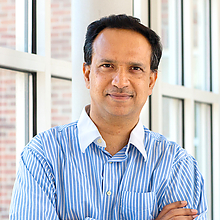Manocha's Research on the Science of Crowds Highlighted by Media

Research on the science of crowds by Dinesh Manocha, a professor of computer science and a professor of electrical and computer engineering at the University of Maryland, was recently featured in the news magazine The Week.
Manocha and his team are the first to their knowledge to develop a crowd simulation model that integrates physiological, psychological and physical factors. Understanding the science behind a crowd in panic is vital to help prepare for and manage emergencies, such as a terrorist attack.
Last year, Manocha was named the inaugural Paul Chrisman Iribe Endowed E-Nnovate Professor. He also has an appointment in the University of Maryland Institute for Advanced Computer Studies.
In Manocha’s paper on crowd simulation, he and his colleagues describe their unified model CubeP, which can reliably predict changes in physical strength consumption and the panic emotion of individuals in an emergency situation. They applied CubeP to videos of real emergencies—including the one on the Shanghai subway system in 2014, and outside the British Parliament building in 2017. The Week article points out that their simulations were closer to reality than any other previous research.
“This improvement illustrates the power of a multidisciplinary science of crowds,” says the article. “As the insights accumulate, they are sure to be useful in architectural design and disaster planning.”
—story by Maria Herd
